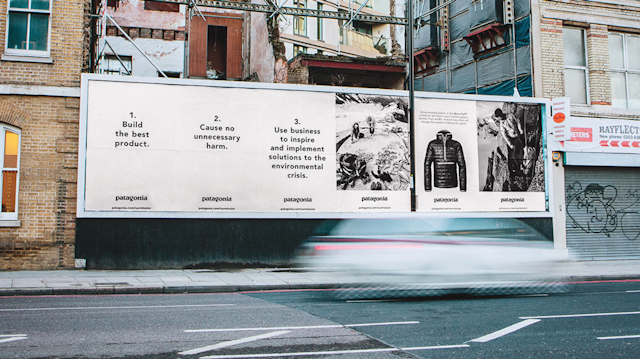
Advertisement
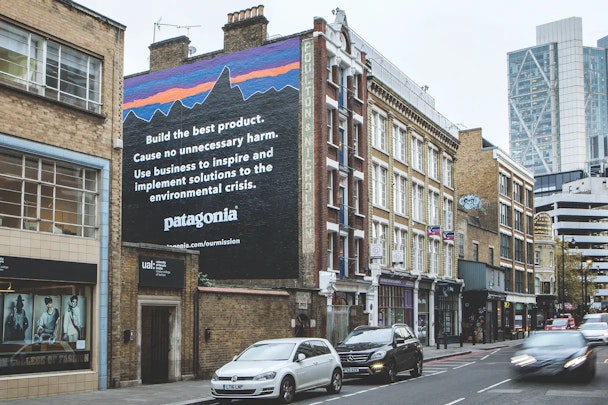
Patagonia mural Shoreditch / Patagonia
Patagonia’s forays into marketing have always been a little unorthodox, seemingly eschewing profit for the sake of purpose. But one doesn’t have to exclude the other, as the brand’s European marketing director Alex Weller tells us.
Early last year, Patagonia’s European marketing director Alex Weller was sitting with two creatives in the outdoor clothing company’s Amsterdam offices, bouncing around ideas for a brand campaign. As they talked tactics and scribbled suggestions, their eyes, and their conversation, kept being drawn to a few thick lines of text enshrined on the wall down the hall. After a while, it dawned on them – the killer campaign they had been searching for had been staring them in the face the whole time.
Come November, giant murals started appearing on the sides of buildings in London’s Shoreditch. The medium didn’t look like advertising, and neither did the message – a facsimile of those words inscribed on Patagonia’s own walls: “Build the best product. Cause no unnecessary harm. Use business to inspire and implement solutions to the environmental crisis.”
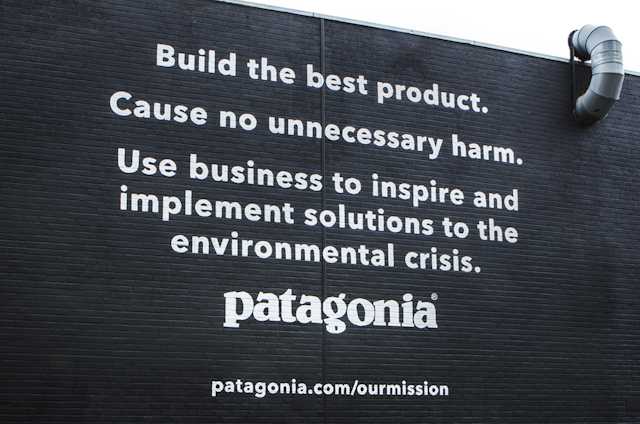
This is Patagonia’s mission statement, and turning it inside-out to become a dramatic consumer campaign is entirely in keeping with the brand’s atypical approach to marketing. Ever since it was founded in California in 1973 by climber Yvon Chouinard, Patagonia has revelled in its idiosyncrasies. Indeed Chouinard, who remains its owner, made his disdain for conventional corporate practices clear in his 2006 memoir ‘Let My People Go Surfing: The Education of a Reluctant Businessman’. “When I die and go to hell,” he wrote, “the devil is going to make me the marketing director for a cola company. I’ll be in charge of trying to sell a product that no one needs, is identical to its competitors and can’t be sold on its merits.”
Weller, a former Converse and Microsoft marketer, is entrusted with growing the brand in Europe and ensuring it does so while living up to 78-year-old Chouinard’s commandments. So those eye-catching murals he commissioned, while true to Patagonia’s principles, were an attempt to gain awareness in a market where it lags behind rivals such as ubiquitous The North Face in both sales and brand recognition. “We had an opportunity to put the company’s reason for being out there and to do it in a straightforward way,” Weller says. “The most straightforward way we could think of as the core piece of the communication plan was to write the mission statement big – writ large, on a wall.”
By the standards of ordinary business behaviour, Patagonia’s practices often appear unorthodox. Since 1985, it has pledged 1% of all annual sales to the preservation of the natural environment, donating more than $74m to sustainability causes through its ‘1% for the planet’ initiative so far. It took its philanthropy even further on Black Friday last year when it promised to give away all of its sales on that bumper shopping day to grassroots green organisations, and promptly racked up a record $10m sales. But the best example of what makes Patagonia so flummoxing was its 2011 press ad for its best-selling R2 fleece, carrying the immortal headline: “Don’t Buy This Jacket.”
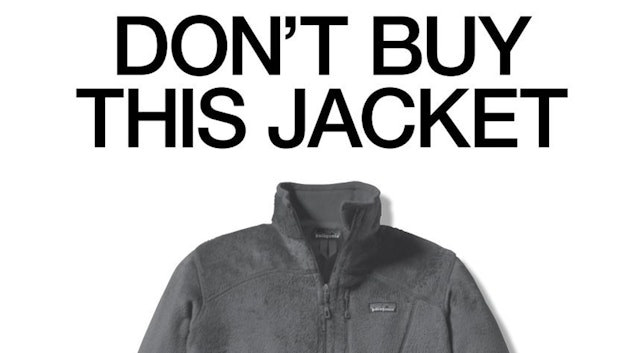
With its stark black and white art direction, and nakedly anti-consumerist copywriting, ‘Don’t Buy This Jacket’ became the stuff of advertising legend and set the tone for how the brand would talk to customers thereafter. “The environmental cost of everything we make is astonishing,” the copy read, astonishingly. Despite the honesty – or, a cynic might suggest, because of it – Patagonia’s sales increased, and today the business enjoys global sales of over $600m. As a 2015 New Yorker brand profile put it: “It is confounding to try to draw lines around when Patagonia’s marketing encourages sales and when it discourages them.”
As a success story of capitalism promoting an anti-consumerist agenda, Patagonia perplexes outsiders. But Weller sees no conflict in its pursuit of both profit and purpose, smoothing away the contradictions by insisting the more down jackets and cotton fleeces the company sells, the more it can do for the planet. “The way the company thinks about the tension between business and doing good is really through the direct cause and effect of business success and the ability to make a positive impact,” he says. “So, of course, selling our product is an important part of our business model – it’s a for-profit company. And the performance of the business has a direct effect on the amount of money we are able to contribute through ‘1% for the planet’. The two things are intrinsically linked. The business doesn’t really shy away from that fact.”
Advertisement
What Patagonia has recognised is that doing good is good for its business. So while its rare marketing campaigns might shout ‘think twice’ to get consumers’ attention, the subtext is always ‘don’t think at all about buying anything else’.
“The real message of ‘Don’t Buy This Jacket’ – and it continues to be the real message of Patagonia in terms of consumption – is don’t buy this jacket if you don’t need it,” says Weller.
“And if you do need a jacket, make sure you buy something that is thoughtfully produced, is built to be repaired, has a clear purpose. So it’s not about encouraging people to not own things; it’s about changing people’s relationship with stuff, and being not just thoughtful consumers but thoughtful and careful owners of stuff.”
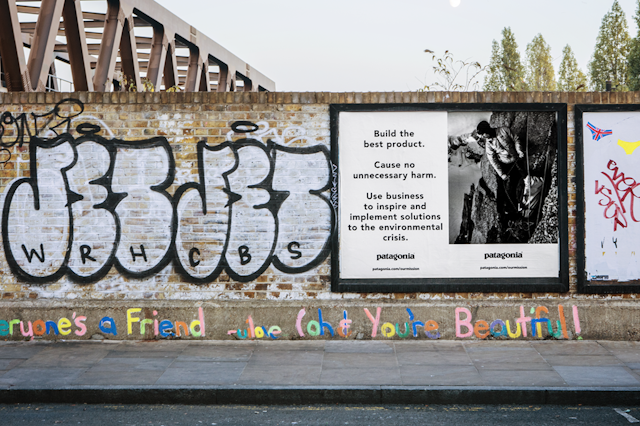
The New Yorker christened the company's dilemma of wanting to grow as a business, while not wanting to encourage environment-harming consumption, as the ‘Patagonia paradox’. And though it is easy to be sceptical, the company's Worn Wear repair and care service, which has been touring Europe fixing gear for free, suggests it is turning slogans into substance. Tapping into a trend towards more conscious buying and ownership, which has also been harnessed to good effect by fashion brands like Asket, Everlane and Nudie, Patagonia encourages its customers to reuse and recycle their clothes rather than send them to landfill. In the shadow of the murals in Shoreditch in November, it opened a pop-up thrift shop selling second-hand products. Queues formed around the block.
Advertisement
Patagonia sees more value in this kind of activity – real contact with consumers – than traditional advertising, which it typically shuns. Even its most infamous campaign only ran once, in the Wall Street Journal. “The role of advertising is to distil something down into a digestible piece of information, and that often means dumbing down, for want of a better word, what is complex narrative,” explains Weller. “On the whole, we prefer to talk in long-form. And we prefer to talk either directly through our own channels and our own experiences we create, or through working with media and partners to help us tell our story. The role of advertising in simple terms doesn’t fit into that.”
As a result, Patagonia has a different relationship with its creative agencies than other brands would. Not only because the brand’s output is less prolific than the norm, but because its deeply ingrained philosophy means it has a fairly good idea of what it is looking for before even writing a brief. For the agencies, that means having to draw on a greater degree of restraint than they might with other clients.
Being faithful to Patagonia’s principles was certainly on the mind of Harriman-Steel, the London studio which brought its murals to life by knocking on the doors of local businesses and asking for permission to paint the sides of their walls. “It starts with asking Patagonia ‘is this true and can we stand behind it?’ and then ‘how do we communicate this in a way that’s meaningful to our audience?’” says creative director Julian Harriman-Dickinson.
He admits the agency had to rein in its original mural idea. “We wanted to give the consumer a bloody nose in a way that was a bit more abrupt or abrasive, to make people actually sit up and take notice of the brand and reassess what it was about. In retrospect that wasn’t right, because that felt like artifice; it felt like we were putting too much spin on it when we didn’t need it.”
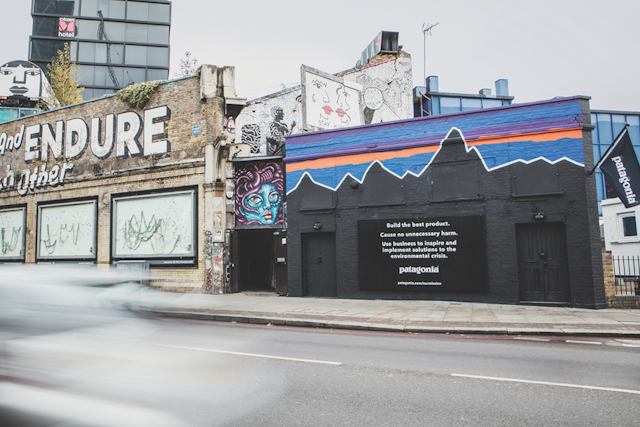
It is this acute sense of authenticity that distinguishes Patagonia from the legions of others talking about the fashionable subject of purpose right now, according to Harriman-Steel’s chairman James Scroggs. “Patagonia is one of those businesses that stands out because its very founding DNA is about purpose – it’s not something it has turned the taps on latterly because the audience has started to get a bit progressive on that.”
Patagonia’s philosophy does not feel phoney because it is not a retrofitted marketing affectation; Scroggs says the mission statement was like “a north star” in those initial conversations in Amsterdam. “What blows my mind is a lot of people don’t actually know how to define purpose,” he adds. “And what some people do is put it in a CSR pot, at which point they appoint somebody who is the ‘king of CSR’ or ‘the queen of CSR’, and they are a sort of strange headmaster, a moral mistress that wanders around. And then there are those who actually understand purpose is much more fundamental to the role they play in the customer’s life, and the moral or ethical credentials mean the customer can stand by the brand and think ‘this adds value to my world’.”
Adding value to both the consumer’s world, and the world at large, was always Chouinard’s intention. As he wrote in Let My People Go Surfing: “I’d much rather design and sell products so good and unique that they have no competition.” In that sense, and as a still relatively little known brand in Europe, Patagonia has work to do. But it will be able to draw on one thing its competitors can’t – a sense of purpose money can’t buy.
